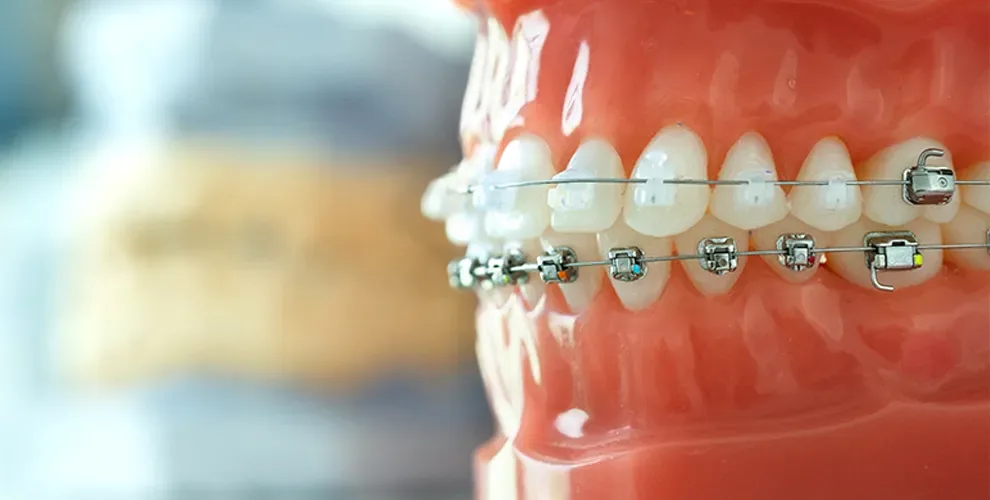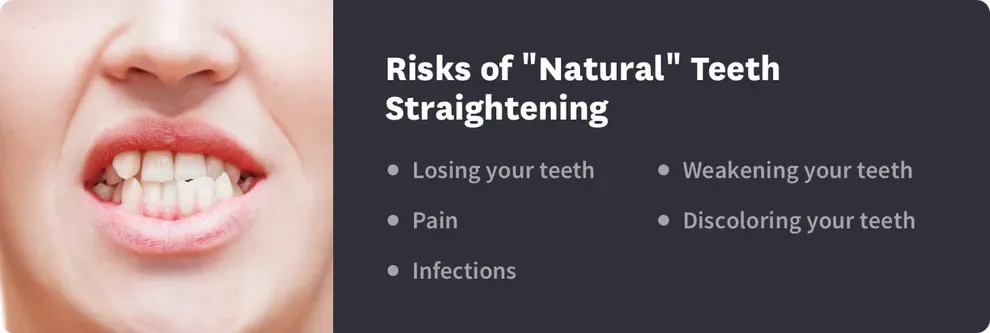Naturally Straighten Teeth: Is It Worth It & Does It Work?

Table of Contents
- Risks of Natural Teeth Straightening
- How to Straighten Teeth Naturally
- Why Don't These Methods Work?
- Alternative Options
- Natural Teeth Straightening FAQs
- References
There is no safe way to naturally straighten your teeth at home alone without the help of a dentist or orthodontist.
Gnawing on sticks, applying rubber bands, or pushing on your teeth with your tongue or your fingers won't improve your smile. These methods can hurt your teeth instead, and sometimes, the damage is permanent.
Almost 13 percent of orthodontists have seen a patient that tried do-it-yourself teeth straightening methods. Don't be one of these patients.
Keep reading to find out how you can safely improve your smile. Safe solutions could be less expensive than you thought.

What are the Risks of Naturally Straightening Teeth?
Natural teeth straightening methods are often sold as safe do-it-yourself options for teeth alignment. But your teeth and bite are more sensitive than you may realize.
Your bite — the way your upper and lower teeth come together — has a huge impact on your oral health as well as on daily activities like eating and talking. Using natural straightening methods can change your bite. This may sound appealing if you’re trying to straighten your teeth.
But with DIY methods, there is no planning involved and no way to know how your bite will be impacted. These “natural” options could easily make your bite worse and result in problems like tooth abrasion, gum irritation, jaw disorders, and further teeth misalignment.
These methods may also stretch or strain muscles, cause tooth pain, or even result in infection.
How to Straighten Teeth Naturally
Because of the risks involved, there really are no recommended ways to straighten teeth naturally. Still, some methods are commonly used. These include the following:
Tongue Thrusts
In an effort to shift teeth forward, people push their tongue against their teeth.
Risks of Tongue Thrusting
Not only is tongue thrusting not effective, but it can also cause soreness, teeth shifting, and tongue and gum irritation.
Rubber Bands
With this method, a rubber band is placed around two teeth that have a gap or extra spacing between them. The band, sometimes called a gap band, is supposed to apply pressure to bring the teeth closer together and close the gap.
Risks of Rubber Bands
Rubber bands or gap bands are a popular natural straightening option and perhaps one of the most dangerous. The pressure applied by the bands can cause pain and gum damage, even affecting tooth roots.
The bands can slide up into gum tissue, where they can’t be seen or removed. This is dangerous, as it could cause infection. Tooth loss is also a risk. One person tried this method, and he lost his bands. His teeth started to protrude and push forward. Then, he lost both teeth at the root.
Stick Chewing
Gnawing on a stick (or other firm item) is supposed to put pressure on teeth and help them move into an ideal bite.
Risks of Stick Chewing
Constant chewing will not correct a bad bite. It could, however, put unnecessary strain on the jaw, wear down tooth enamel, and increase the risk of tooth damage.
Pushing
After finding a tooth out of alignment, one simply pushes it into place with their finger, applying pressure throughout the day.
Risks of Pushing
Pushing on your teeth can cause pain, gum irritation, and soreness. It could even increase your exposure to germs and bacteria due to putting your finger in your mouth repeatedly.
Why Don't These Methods Work?
These natural methods are ineffective (and often harmful) for various reasons.
They call for the application of pressure without knowing how teeth will respond to that pressure. For example, even if a rubber band did move a tooth to close a gap, what then happens to the rest of the teeth? They may shift and a gap may be created elsewhere. The bite may then be shifted to create abrasion between two teeth elsewhere. The overall bite may be worse.
They use pressure that may cause harm to the gums, teeth, and jaw. For example, if one pushes continuously on a crooked tooth, it may cause movement. Rapid movement that could cause nerve pain, damage gums, trigger inflammation, and cause the rest of teeth to shift into deeper misalignment.
Orthodontic problems require a treatment plan, not just the forced ineffective movement of a tooth. Natural teeth straightening doesn’t work and could cause serious and irreparable damage to your teeth and oral health.
Alternatives to Natural Teeth Straightening
When it comes to teeth straightening, there are two main treatment options: braces and clear aligners.
Braces use brackets that are cemented to the teeth. The brackets are then connected through an archwire that extends over the teeth and is tightened during regular orthodontist visits. This tightening applies pressure that moves teeth into a corrected position.
Clear teeth aligners are custom-made clear trays that fit over teeth. After analyzing where your teeth are currently and where they need to be for an optimal bite, a series of trays is created to progressively shift teeth. Each tray is removable and worn for a week or two before moving on to the next one. After your last tray, teeth will be in alignment.
You may notice that both braces and aligners use pressure to move teeth, as the natural teeth straightening methods do. So, what’s the difference?
With braces and aligners, a treatment is designed specifically to correct your issues. A plan is followed and monitored, and your bite, oral health, and comfort level are taken into consideration.
Some aligners are provided by a dentist or orthodontist, with regular check-ins, similar to braces treatment. At-home aligners offer a more modern approach, with an entirely remote treatment process featuring an at-home impression kit and virtual check-ins.
For those seeking less traditional treatment through natural methods, aligners may be a smart choice. You are still more in control of your treatment, but you get the benefits and care of a doctor-monitored treatment plan.
Natural Teeth Straightening Frequently Asked Questions
No. There is no safe or "natural" way to straighten your teeth alone. You'll need a dentist or orthodontist to help you.
You can't straighten your teeth without braces or aligners.
